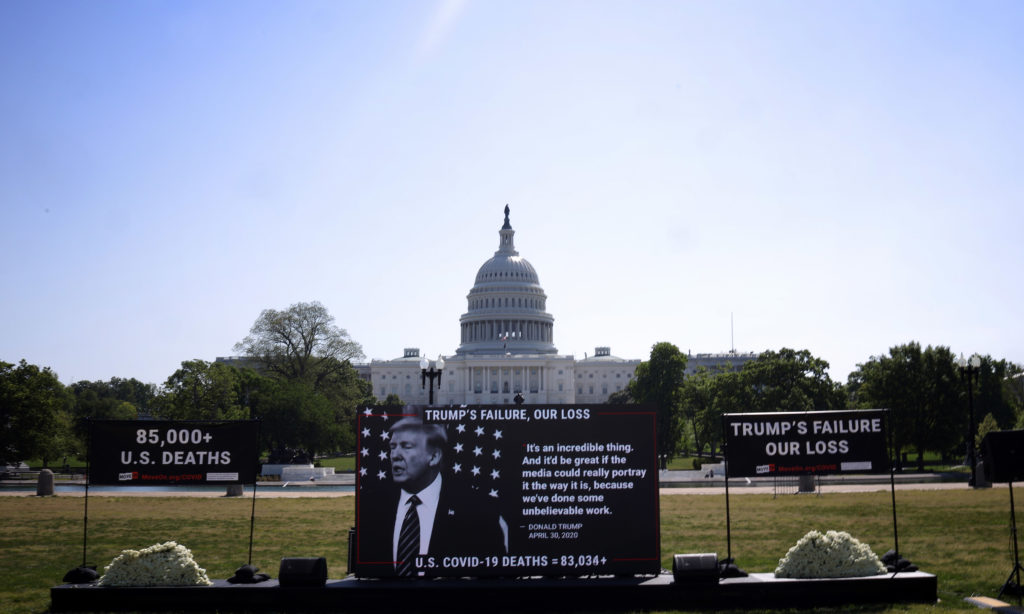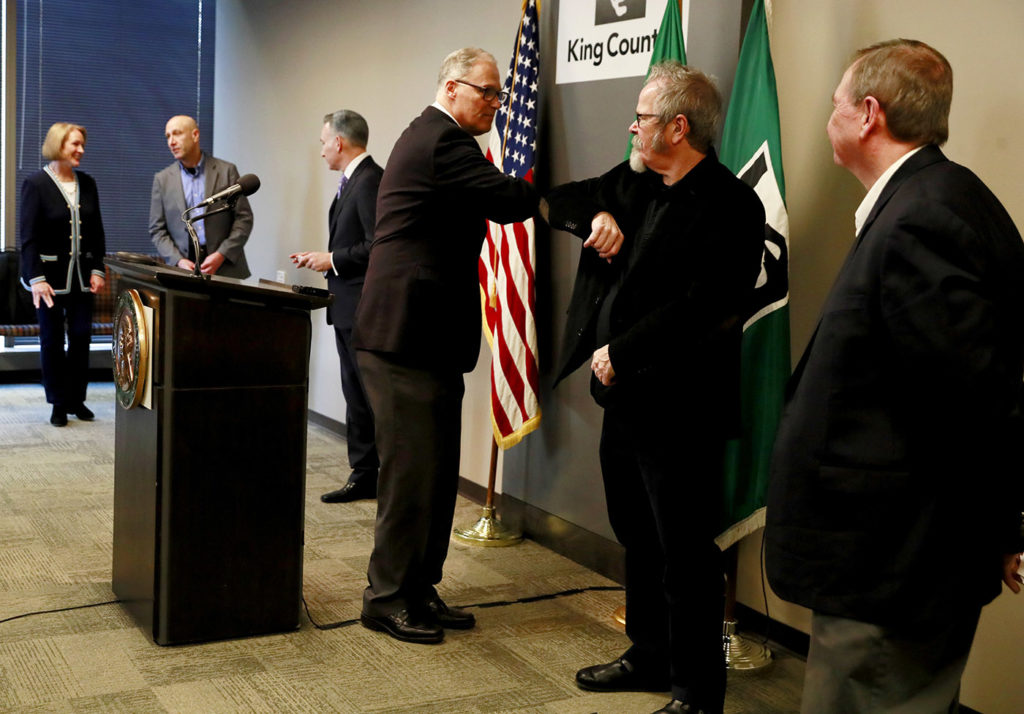In Response to the Coronavirus, Governors Are the Real Leaders

We’re entering into a scary new phase of the novel coronavirus pandemic. As many states are lifting lockdown orders, the Centers for Disease Control and Prevention recently estimated that the death rate is likely to increase to nearly 3,000 people per day by June 1. The Institute for Health Metrics and Evaluation on May 12 raised its estimate of the total U.S. deaths to 147,040 by August.
Given how badly the U.S. has bungled its response to the outbreak so far, it’s an open question whether anyone can rise to the challenge of leading us through the likely second and subsequent waves of the pandemic.
It’s clearly not President Trump. Even as he acknowledged on May 3 that as many as 100,000 Americans might die from the disease—an already outdated number as the death tally rose past 80,000 last week—Trump is also encouraging states to end the social distancing and quarantine measures that in some places are in their 10th week. Some states, such as Georgia, which started reopening the week of May 4 despite not having met the federal government’s already weak guidelines, are likely not prepared for a second wave of infections.
The pandemic has revealed a near total collapse of federal leadership.
It’s not even clear we can look to any single national figure for guidance, except perhaps Dr. Anthony Fauci of the National Institute of Allergy and Infectious Diseases. As of this writing, Fauci himself is in isolation after an outbreak of coronavirus infections emerged within the White House.
Instead, the pandemic has revealed a near total collapse of federal leadership. In many ways, that was the plan all along. This is what former presidential adviser Steve Bannon meant when he said the goal of this administration was the “destruction of the administrative state,” even if he couldn’t have predicted that a virus would provide the assist.

But instead of a unified federal response, we have state and local governments all scrambling to respond, even as individual counties and cities buck their governors. This comes on top of increased polarization and factionalism that has severely frayed the social fabric that once defined “Americanness.”
It’s true that many responsibilities are best left to the states, if only for the simple reason that smaller populations are easier to manage when it comes to things such as providing clean water and electricity, issuing business licenses, educating children, and keeping the streets paved.
National interests take precedence in those areas where you need the scale that only a population of 320 million people and an economy measured in trillions of dollars can deliver, such as defense and public health. If a nation can’t protect its citizens, or doesn’t even try, then it’s failed as a state. A government that only protects the interests of its leaders bears more resemblance to a mafia family than a nation of laws.
Some Republican governors, like Georgia’s Brian Kemp, are giving service workers a choice between two bad options: Go back to work (without paid sick leave) and risk serious illness, or stay home and lose your job or unemployment (and maybe your home, too). It’s not that hairstylists and tattoo artists are essential workers, but that Kemp and other Republicans don’t want to have to pay unemployment benefits.
Governors are flying blind to fill the power vacuum created by the lack of federal response.
It’s notable that, as of today, Trump still has not fully invoked the Defense Production Act, with which he could have directed U.S. manufacturers to make necessary and still-scarce medical and protective equipment such as masks, gowns, and ventilators. The only case in which he did invoke the act was to force South Dakota meatpackers to go back to work in a plant that was already the country’s biggest viral hotspot. Also notable in light of Trump’s relentless attacks on already marginalized communities: immigrants and people of color make up a disproportionate share of workers in the meatpacking industry.
And instead of modeling unified leadership, Trump has pitted states against each other to obtain their own equipment, while at the same time having the federal government outbid the states, and at times, seizing those states’ shipments for a federal stockpile to be doled out to sufficiently deferential governors. The federal government has acted like a hostile occupying foreign power, not as an ally of the states that make up the United States.
That’s what led Maryland Gov. Larry Hogan, a Republican, to work back channels to virtually smuggle 500,000 test kits into the U.S. from South Korea so the feds wouldn’t engage in PPE piracy, and secure them at an undisclosed location protected by the Maryland National Guard. Gov. Jared Polis of Colorado, a Democrat, also is keeping equipment orders a secret out of fear they’ll be intercepted.
Most Republican governors, like Kemp, are itching to lift lockdown orders regardless of the public health risks, while most Democratic governors trying a more cautious approach.
But another interstate dynamic is ultimately more telling: Governors are flying blind to fill the power vacuum created by the lack of federal response.
In this new experiment in federalism, the states are indeed supreme. They can appeal to the Trumpified feds for additional money, but as it’s become clear, this is not a functional system with standardized procedures and predictable outcomes. Rather, it’s an appeal of subjects to the sovereign for a beneficial decision. And if the sovereign doesn’t like you or what you say about him, your calls aren’t returned.

States now are more likely to help each other, such as when Washington Gov. Jay Inslee sent excess ventilators to New York, where they were needed more. And many states are forming alliances to coordinate the reopening of their economies. California, Oregon, and Washington are coordinating their efforts to reopen, and Nevada and Colorado have since joined up with the Pacific pact states. Several Midwestern states stretching from Minnesota to Kentucky also are working together. Seven eastern states, including hard-hit New York and New Jersey, have joined forces to plan their reopening and to combine their purchasing power for medical equipment.
And, while Trump’s news briefings are basically campaign rallies for him to air his grievances, rail against political enemies, and deny responsibility for his administration’s failures, New York Gov. Andrew Cuomo has drawn accolades from across the country (and even a musical tribute) for his calm reassurance and commitment to factual information.
This interstate collaboration is, in part, a recognition by sensible governors that, according to the collective wisdom of the internet, you can’t really have a dedicated peeing section in the swimming pool. But it’s also a sign that increasingly, the states truly are on their own. The late House Speaker Tip O’Neill famously said that all politics is local, but we’ve now entered an era where all governance is local, too. It’s almost a form of secession by default.
Rhode Island Gov. Gina Raimondo, a Democrat, exerted a bit of border control early on, turning back cars with New York license plates at the state line, then expanding the ban to all out-of-state vehicles. Florida and North Carolina are setting up similar checkpoints in tourist-heavy areas. And Native American tribes, most notably the Cheyenne River Sioux Tribe in South Dakota, have set up checkpoints on roads crossing their reservations, invoking their status as sovereign nations with inherent rights. Some of those measures may run afoul of the U.S. Constitution, but when the federal government won’t take responsibility for public health, local leaders have stepped up.
At the core of a successful pandemic response is having political leaders who want to do right by the people.
One thing that states can’t do is print money. They still need the U.S. Treasury, and unlike the federal government, states can’t just ramp up their deficits and debts for critical needs.
But Trump has made clear which states he thinks don’t deserve aid, and his view is shared widely among Republicans. Senate Majority Leader Mitch McConnell has been adamantly opposed to giving the states more federal aid, calling it “blue state bailouts” and saying states should just file for bankruptcy instead.
It’s probably why Gov. Gavin Newsom has referred to California as a “nation-state” on more than one occasion. He’s trolling Trump a bit, but it’s also a sly reminder that California, with a GDP of $3.18 trillion, can go its own way if it wanted to, and take the world’s fifth-largest economy with it.
This isn’t to say secession is a good or even legal idea (not even for Texas). But the countries that have so far been getting ahead of the coronavirus curve with effective public health measures, such as South Korea, Taiwan, New Zealand, and Denmark, are mostly on the smaller side. Larger and even some midsize nations haven’t done as well.
Size isn’t everything. Rigorous testing and contact tracing, and a robust public health system also play important roles, as does public trust in government and experts to generally get things right. There may be many more factors that we simply haven’t yet learned.
But at the core of a successful pandemic response is having political leaders who want to do right by the people, and not exploit the crisis for profit and political advantage. If Joe Biden defeats Trump in November, the federal government may have an opportunity to reassert its legitimacy. In the meantime (and especially if Trump wins again), power is lying in the street, and it’s our local leaders who are picking it up.

|
Chris Winters
is a senior editor at YES!, where he specializes in covering democracy and the economy. Chris has been a journalist for more than 20 years, writing for newspapers and magazines in the Seattle area. He’s covered everything from city council meetings to natural disasters, local to national news, and won numerous awards for his work. He is based in Seattle, and speaks English and Hungarian.
|







